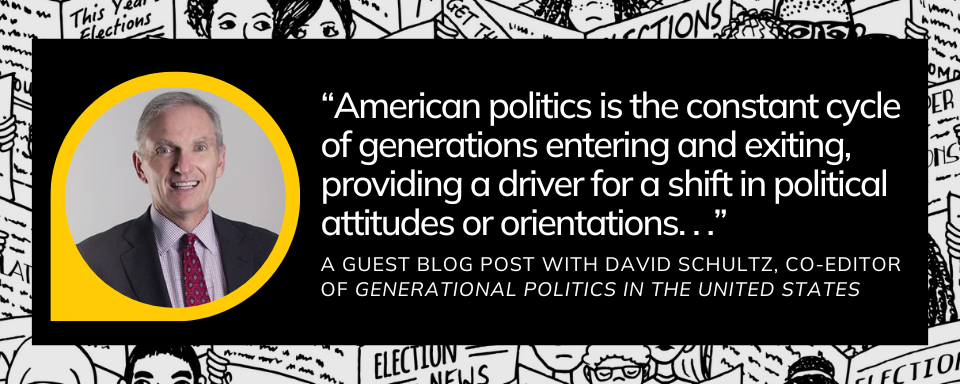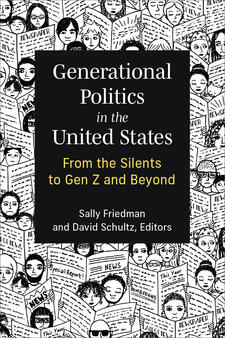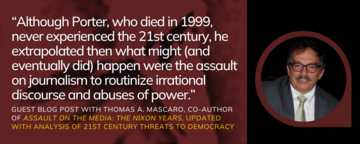Generational Politics and Political Polarization in America

This guest author post is written by David Schultz, co-editor of the new book Generational Politics in the United States: From the Silents to Gen Z and Beyond, from the University of Michigan Press. The book will be published in hardcover, paperback, and open access.
Every generation wants a revolution. Every generation wants to change the world. The fact that some readers recognize the origins of this phrase, while others do not, speaks to the reality of two issues in American politics: political polarization and generational differences. While generational difference in part is driving the current polarization, according to the research in our new book, generational change in the future may erase it.
One of the most profound changes in American politics in the last fifty years has been the dramatic increase in political polarization. Political polarization in American politics is real and driven by many factors, including the shift in generations over time.
Back in the 1970s, American politics could be described as a bell curve distribution of public opinion. While there were some who identified as politically far right or politically far left, the vast majority of the population converged in the center. The entire logic of the American political system was based upon a broad centrist consensus which drove the two political parties to work together in Congress. As a result, high percentages of bipartisan legislation and significant productions of bills were passed into law.
But over the last fifty years, we've witnessed a dramatic shift. That bell shaped curve has broken down, and now it looks more like a bimodal curve. The percentage of the population describing themselves as centrist has decreased. Meanwhile, the percentage describing themselves as far left or far right has increased. The two political parties have ideologically sorted themselves out, such that the centers of the two parties have diverged. There is now little desire or ability of the parties to compete for the center. The result in Congress is very little bipartisan legislation. And very little legislation at all.
Many factors account for this polarization. The increased role of special interests in money and politics are causes. There is also rising economic inequality in our society. But often overlooked is the fact that over the last fifty years, several generations have entered and exited the political system. American politics is defined by generations in generational shifts.
A generation can be defined as a group of individuals born roughly at the same time and socialized in their adolescence around some defining event or set of experiences that fix their political orientations for the rest of their life. It is not until approximately 20 years later that this generation can take power as an older generation has exited the political system. American politics is the constant cycle of generations entering and exiting, providing a driver for a shift in political attitudes or orientations, and also for the possibility of political conflict if not polarization.
While there is some dispute over the dates marking generations, “the greatest” or WWII generation was born between 1900 and 1924, and has largely exited from American politics. We are now seeing the last vestiges of the Silent Generation (1925-1945). The Baby Boomers (1946-1960) are exiting, as are Gen X (1961-1981), only to be replaced by the Millennials (1982-1995) and Gen Z (1916-2013), and now Generation Alpha born after 2013.
When we look across these generations, our research generally finds profound differences. Millennials and Gen Zs by far described themselves as the most liberal on a whole range of issues regarding social matters, the economy, immigration, and others. These two generations are also the most racially and demographically diverse in American history and are the least religious of any generation, especially compared to previous generations. Millennials generally vote differently than older generations, and their governing style as elected officials appears to be different. One exception to the differences? Millennial and Gen Z males without a college degree share political attitudes more like their grandfathers than their peers.
The demographic and political orientations of the older Silents and Baby Boomers clash with those of the Millennials and Gen Z. It is this generational clash that is one of the powerful contributing causes of political polarization in the US today, carrying over into partisan identification and policy.
The 2020 presidential election was significant in that it was the first in 30 years where the Baby Boomers did not constitute the largest generation as a voting bloc. For the last 30 years, Boomers and the Silents have driven and defined the American political agenda. For the most part, the Silent generation, as well as the younger Baby Boomers, were the core of the Republican Party. The older Baby Boomers along with many GenXers, formed the core of the Democratic Party. The Millennials and Gen Z, while leaning liberal and thus more likely to vote for Democrats, are not sold on the current Democratic Party whom they see as more dominated by Baby Boomers. They also do not appear oriented toward the Republican Party.
Going forward, we'll see the Silents, the Baby Boomers, and Gen Xers exit politics, only to be replaced by Millennials and Gen Z's who are less likely to define themselves as Republican or Democrat. Both the Democrats and the Republicans face an existential crisis in terms of recruiting a new generation for their party, and both are open for significant political change in terms of their composition and ideology. We already see what political scientists call a critical realignment in the parties that could also affect American politics in general.
What does this all mean for polarization in America? As generations shift there will be a new political center in the US. It will be a more secular center. Look to see greater consensus on LGBTQ+ issues as religiosity declines. There will also be more consensus on social welfare spending, guns, and the environment.
The question becomes, what does this mean for polarization? Demographics are not destiny and it is foolish to forecast this as some analysts once did. But generational shifts portend possibilities.
Will a new center of American politics revolve more around urban politics or will it converge around a more suburban agenda? Given the growth of suburban population and where most of the new congressional seats are, the likelihood is that the future of American politics revolves around more centrist suburban politics characterized by and driven by two new generations, more secular and less divided. This suggests something reapproaching a new bell curve in American politics, perhaps heralding a decrease in the polarization currently driven in part by generational differences.



